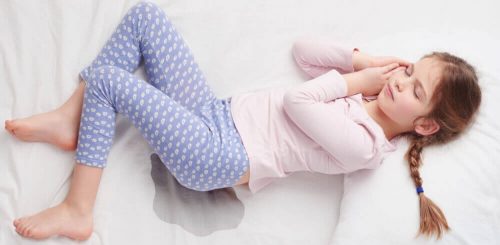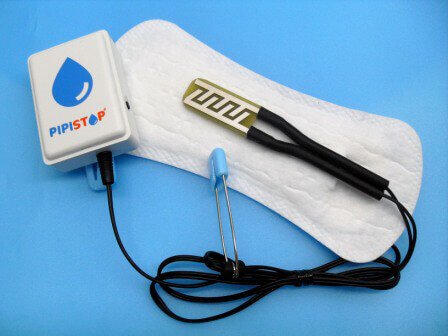Enuresis: Causes, Symptoms, and Treatments

The elimination of body waste is a basic function that our body performs instinctively from birth. In the first years of life, elimination is a part of a process that eventually allows us to be completely autonomous. This evolutionary process usually extends into the fourth or fifth year of life. These lessons end up teaching us self-care habits.
Sphincter control usually follows a sequence that’s common in most children. The first thing that children acquire is nocturnal fecal continence. That’s our ability to control intestinal emptying during sleep. Second, children usually acquire daytime fecal control. Soon afterwards, children usually achieve diurnal urinary continence. Finally, children obtain nocturnal urine control, and this usually takes the longest to learn.
Sex also controls at what age we control the sphincter. Normally girls acquire control before boys. Boys lag behind girls, and this lag can range from a few months to 2 to 3 years. In spite of this variability, it’s normal for training to begin at 18 months of age and take until the child is between 3 and 5 years old. After this time period, lacking urinary or fecal control is considered problematic.
There are few children who, after they’re 5 years old, are still urinating during the day or at night. This causes discomfort for both children and parents.

What is enuresis?
Traditionally, enuresis is defined as an evolutionary and persistent discharge of urine. This discharge occurs during the day, night, or at both times after 4-5 years of age. In other words, the term enuresis refers to the repeated, involuntary emission of urine in inappropriate places, such as bedding and clothing in children over 5 years of age. At this age the child should have acquired urinary control without having an organic pathology that motivates incontinence.
Night enuresis is one of the most frequent problems among children. It refers to urination taking place during sleep. Approximately between 10 and 20 percent of 5 year olds have this problem during the night.
Causes of enuresis
Scientists have formulated different hypotheses to explain enuresis’ origin. However, none of the variables that researchers have studied are able to explain the phenomenon by itself. For this reason, the most accepted hypothesis is the multi causal etiology.
The multi-causal etiology refers to the existence of various physiological, maturational, genetic and learning factors. These factors interact with one another to explain each enuresis case.
Physiological factors
To acquire urinary control it’s necessary for the child to learn to identify that their bladder is full. After they recognize this the child should be able to urinate in the right place.
Normally, during the filling phase the bladder is relaxed. The detrusor only contracts when the bladder is completely full. However, in some enuretic cases the patient demonstrates high detrusor overactivity. This causes uncontrolled contractions before the bladder is actually full.
This is why children can show a high urgency to urinate and creates nighttime incontinence. The detrusor overactivity during sleep is responsible for about one third of nocturnal enuresis cases.

Genetic factors
It’s a known fact that enuresis follows a genetic factor. In approximately 75% of all enuresis cases there’s a first degree relative with a family history of enuresis.
Likewise, several genes have been identified that seem to be involved in nocturnal enuresis problems. Even so, the results aren’t completely conclusive.
Learning factors
The voluntary control of urination is a complex phenomenon that requires to sequentially acquire a series of specific skills:
- Recognize signs of distention of the bladder. They must be able to recognize that the bladder is full and be able to communicate that to others.
- Awake and with a full bladder, children must learn to contract the pelvis muscles to retain urine until you reach the right place.
- Relax those muscles to start urination. Control the urine emptying. Be able to stop and start the bladder emptying.
If the sequence isn’t learned properly, it won’t become automated. If it’s not automated the process won’t be transferred to the night in order to achieve nighttime control of urination.
Enuresis symptoms
As we saw earlier, the main symptom of enuresis is the loss of urine, whether involuntary or intentional. It shows up with a frequency of two episodes per week during a period of at least three consecutive months.
Enuresis causes clinically significant social and academic discomfort. Some children with nocturnal enuresis may wake up constipated.

Treatment for enuresis
There are several treatments for enuresis that include pharmacological treatment to behavioral treatment. In pharmacological treatment, one of the most used drugs has been imipramine, a tricyclic antidepressant.
In recent years, doctors have replaced imipramine with desmopressin, which is an analogue of the antidiuretic hormone (vasopressin). It facilitates the kidney’s reabsorption of water so that there’ s a reduction in the volume of urine.
Regarding behavioral treatment, we can say that it’s a consolidated psychological intervention. This treatment derives from three basic procedures: the alarm method, training in urine retention, and training in dry bed.
So, if one of your children suffers from enuresis, it’s best to visit a specialist psychologist. Psychologists believe that behavioral treatment is most effective and the side effects of the drugs are avoided.
Bibliography:
Comeche Vallejo, I., Vallejo Pareja, M.A. Manuel de terapia de conducta en la infancia. Dykinson-Psicología. Madrid, 2012.
Bragado Álvarez, C. Enuresis infantil. Pirámide. Madrid, 2006.
The elimination of body waste is a basic function that our body performs instinctively from birth. In the first years of life, elimination is a part of a process that eventually allows us to be completely autonomous. This evolutionary process usually extends into the fourth or fifth year of life. These lessons end up teaching us self-care habits.
Sphincter control usually follows a sequence that’s common in most children. The first thing that children acquire is nocturnal fecal continence. That’s our ability to control intestinal emptying during sleep. Second, children usually acquire daytime fecal control. Soon afterwards, children usually achieve diurnal urinary continence. Finally, children obtain nocturnal urine control, and this usually takes the longest to learn.
Sex also controls at what age we control the sphincter. Normally girls acquire control before boys. Boys lag behind girls, and this lag can range from a few months to 2 to 3 years. In spite of this variability, it’s normal for training to begin at 18 months of age and take until the child is between 3 and 5 years old. After this time period, lacking urinary or fecal control is considered problematic.
There are few children who, after they’re 5 years old, are still urinating during the day or at night. This causes discomfort for both children and parents.

What is enuresis?
Traditionally, enuresis is defined as an evolutionary and persistent discharge of urine. This discharge occurs during the day, night, or at both times after 4-5 years of age. In other words, the term enuresis refers to the repeated, involuntary emission of urine in inappropriate places, such as bedding and clothing in children over 5 years of age. At this age the child should have acquired urinary control without having an organic pathology that motivates incontinence.
Night enuresis is one of the most frequent problems among children. It refers to urination taking place during sleep. Approximately between 10 and 20 percent of 5 year olds have this problem during the night.
Causes of enuresis
Scientists have formulated different hypotheses to explain enuresis’ origin. However, none of the variables that researchers have studied are able to explain the phenomenon by itself. For this reason, the most accepted hypothesis is the multi causal etiology.
The multi-causal etiology refers to the existence of various physiological, maturational, genetic and learning factors. These factors interact with one another to explain each enuresis case.
Physiological factors
To acquire urinary control it’s necessary for the child to learn to identify that their bladder is full. After they recognize this the child should be able to urinate in the right place.
Normally, during the filling phase the bladder is relaxed. The detrusor only contracts when the bladder is completely full. However, in some enuretic cases the patient demonstrates high detrusor overactivity. This causes uncontrolled contractions before the bladder is actually full.
This is why children can show a high urgency to urinate and creates nighttime incontinence. The detrusor overactivity during sleep is responsible for about one third of nocturnal enuresis cases.

Genetic factors
It’s a known fact that enuresis follows a genetic factor. In approximately 75% of all enuresis cases there’s a first degree relative with a family history of enuresis.
Likewise, several genes have been identified that seem to be involved in nocturnal enuresis problems. Even so, the results aren’t completely conclusive.
Learning factors
The voluntary control of urination is a complex phenomenon that requires to sequentially acquire a series of specific skills:
- Recognize signs of distention of the bladder. They must be able to recognize that the bladder is full and be able to communicate that to others.
- Awake and with a full bladder, children must learn to contract the pelvis muscles to retain urine until you reach the right place.
- Relax those muscles to start urination. Control the urine emptying. Be able to stop and start the bladder emptying.
If the sequence isn’t learned properly, it won’t become automated. If it’s not automated the process won’t be transferred to the night in order to achieve nighttime control of urination.
Enuresis symptoms
As we saw earlier, the main symptom of enuresis is the loss of urine, whether involuntary or intentional. It shows up with a frequency of two episodes per week during a period of at least three consecutive months.
Enuresis causes clinically significant social and academic discomfort. Some children with nocturnal enuresis may wake up constipated.

Treatment for enuresis
There are several treatments for enuresis that include pharmacological treatment to behavioral treatment. In pharmacological treatment, one of the most used drugs has been imipramine, a tricyclic antidepressant.
In recent years, doctors have replaced imipramine with desmopressin, which is an analogue of the antidiuretic hormone (vasopressin). It facilitates the kidney’s reabsorption of water so that there’ s a reduction in the volume of urine.
Regarding behavioral treatment, we can say that it’s a consolidated psychological intervention. This treatment derives from three basic procedures: the alarm method, training in urine retention, and training in dry bed.
So, if one of your children suffers from enuresis, it’s best to visit a specialist psychologist. Psychologists believe that behavioral treatment is most effective and the side effects of the drugs are avoided.
Bibliography:
Comeche Vallejo, I., Vallejo Pareja, M.A. Manuel de terapia de conducta en la infancia. Dykinson-Psicología. Madrid, 2012.
Bragado Álvarez, C. Enuresis infantil. Pirámide. Madrid, 2006.
This text is provided for informational purposes only and does not replace consultation with a professional. If in doubt, consult your specialist.







